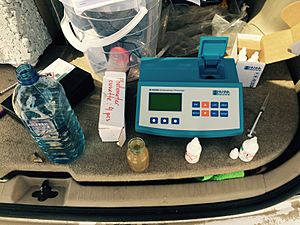Oxygen saturation facts for kids
Oxygen saturation (also called dissolved oxygen or DO) is a way to measure how much oxygen is mixed into a liquid, usually water. Think of it like how much sugar can dissolve in your drink! This oxygen is super important for many living things.
Scientists and environmentalists can measure dissolved oxygen using special tools. These tools include an oxygen sensor or an optode. The amount of dissolved oxygen is often measured in milligrams per litre (mg/l) or parts per million (ppm).
Many living things need dissolved oxygen to survive. This includes fish, tiny invertebrates (like worms or insects without backbones), plants, and even some types of bacteria. They all use this oxygen for a process called respiration. Respiration is how living things get energy from their food.
In medicine, "oxygen saturation" means something a bit different. It refers to how much oxygen is carried by your blood and delivered to the tissues (parts) of your body. This is called oxygenation. It's about ensuring your body's cells get enough oxygen to work properly.
Contents
Why Dissolved Oxygen Matters
Dissolved oxygen is vital for the health of rivers, lakes, and oceans. When there isn't enough oxygen in the water, it can be very harmful to aquatic life. Fish and other creatures might struggle to breathe, get sick, or even die.
How Oxygen Gets into Water
Oxygen can enter water in several ways:
- From the air: Oxygen from the atmosphere can dissolve into the water, especially when the water is moving, like in a fast-flowing river or where waves break.
- From plants: Aquatic plants and algae produce oxygen during photosynthesis. This is the same process land plants use to make their food.
- Water temperature: Colder water can hold more dissolved oxygen than warmer water. This is why some fish prefer cooler waters.
What Affects Oxygen Levels?
Many things can change the amount of dissolved oxygen in water:
- Temperature: As water gets warmer, it holds less oxygen.
- Pollution: Certain types of pollution, especially from sewage or fertilizers, can cause too many bacteria to grow. These bacteria use up a lot of oxygen as they break down the pollution.
- Water flow: Still or slow-moving water usually has less oxygen than fast-moving water.
- Time of day: During the day, aquatic plants produce oxygen. At night, they use oxygen for respiration, so levels might drop slightly.
Measuring Dissolved Oxygen
Measuring dissolved oxygen is an important part of checking water quality. Scientists use special tools called dissolved oxygen probes or optodes. These devices are lowered into the water and give a reading of the oxygen levels. This helps them understand if the water is healthy enough to support aquatic life.
Importance for Aquatic Life
Different aquatic animals need different amounts of dissolved oxygen to survive. For example, some types of trout need very high levels of oxygen, while other fish, like carp, can tolerate lower levels. Monitoring these levels helps protect the homes of many water creatures.
Images for kids
-
Dissolved oxygen levels required by various species in the Chesapeake Bay (US)
See also
 In Spanish: Oxigenación para niños
In Spanish: Oxigenación para niños



